
Sicily is the largest island in the Mediterranean Sea and one of the 20 regions of Italy. The Strait of Messina divides it from the region of Calabria in Southern Italy. It is one of the five Italian autonomous regions and is officially referred to as Regione Siciliana. The region has 5 million inhabitants. Its capital city is Palermo.

The Arbëreshë, also known as Albanians of Italy or Italo-Albanians, are an Albanian ethnolinguistic group in Southern Italy, mostly concentrated in scattered villages in the region of Calabria and, to a lesser extent, in the regions of Abruzzo, Apulia, Basilicata, Campania, Molise and Sicily. They are the descendants of Albanian refugees who fled Albania, and later some from Morea between the 14th and the 18th centuries following the Ottoman conquest of the Balkans.
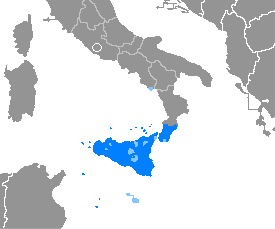
Sicilian is a Romance language that is spoken on the island of Sicily and its satellite islands. A variant, Calabro-Sicilian, is spoken in southern Calabria, where it is called Southern Calabro notably in the Metropolitan City of Reggio Calabria. Dialects of central and southern Calabria, the southern parts of Apulia and southern Salerno in Campania, on the Italian peninsula, are viewed by some linguists as forming with Sicilian dialects a broader Extreme Southern Italian language group.

The genus Tadarida has 9 or more species of free-tailed bats divided into two subgenera, with the first of these containing seven species spread across the Old World. Four species occur exclusively in Africa including Madagascar while two more species occur in central Papua New Guinea, and western and southern Australia, respectively.
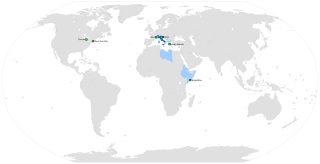
The Accademia della Crusca, generally abbreviated as La Crusca, is a Florence-based society of scholars of Italian linguistics and philology. It is one of the most important research institutions of the Italian language, as well as the oldest linguistic academy in the world.

The muffuletta or muffaletta is both a type of round Sicilian sesame bread and a popular sandwich that originated among Italian immigrants in New Orleans, Louisiana, using the same bread.

The languages of Italy include Italian, which serves as the country's national language, in its standard and regional forms, as well as numerous local and regional languages, most of which, like Italian, belong to the broader Romance group. The majority of languages often labeled as regional are distributed in a continuum across the regions' administrative boundaries, with speakers from one locale within a single region being typically aware of the features distinguishing their own variety from one of the other places nearby.
The primary languages of Calabria are the Italian language as well as regional varieties of the Neapolitan and Extreme Southern Italian, all collectively known as Calabrian. In addition, there are 100,000 speakers of the Arbëresh variety of Albanian, as well as small numbers of Calabrian Greek speakers and pockets of Occitan.
Arbëresh is the variety of Albanian spoken by the Arbëreshë people of Italy. It is derived from the Albanian Tosk spoken in Albania, in Epirus and is also spoken by the Arvanites, with endonym Arvanitika.

Piersanti Mattarella was an Italian politician. He was assassinated by the Mafia while he held the position of President of the Regional Government of Sicily. He was the brother of Sergio Mattarella, who has been the President of Italy since February 2015.

Gallo-Italic of Sicily is a group of Gallo-Italic languages found in about 15 isolated communities of central eastern Sicily. Forming a language island in the otherwise Sicilian language area, it dates back to migrations from northern Italy during the reign of Norman Roger I of Sicily and his successors.
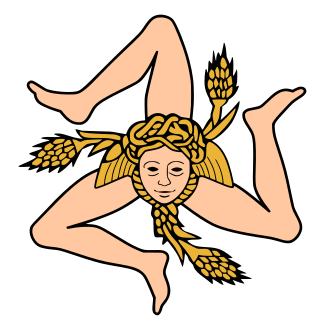
The Movement for the Independence of Sicily was a separatist Sicilian political party originally active in Sicily from 1943 to 1951. Its best electoral result was in 1947, when it won 8.8% of the votes in the Sicilian regional election and had nine regional deputies elected.

In Italy, there are some active movements and parties calling for autonomy or even independence for the areas comprised within the historical Kingdom of the two Sicilies: that is, Southern Italy and/or the region of Sicily. No political movement promoting these ideas has ever been successful in gaining traction among the population. The movement remains on the fringes with no representation in the Italian parliament.
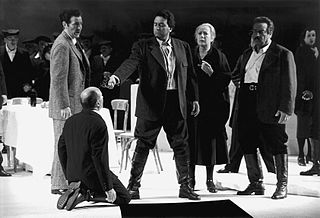
Salvatore Giuliano is an opera in one act by Lorenzo Ferrero to an Italian-language libretto by Giuseppe Di Leva, which was conceived to be performed in tandem with Pietro Mascagni's Cavalleria rusticana. The work was commissioned by the Teatro dell'Opera di Roma and premiered there on 25 January 1986.

Benedetto Lo Monaco is an Italian actor, known for his work in many Italian movies.

Cademia Siciliana is a transnational non-profit organization founded in 2016 by a group of Sicilian language academics, activists, researchers, and students with the mission to promote the Sicilian language through education, research, and activism. The organization has published an orthographical proposal for the Sicilian language, and maintains several Sicilian language research and technology projects. Including translation and language advocacy projects for several popular applications and platforms such as Firefox, Telegram, Facebook and Android Keyboard. In 2021 the group gained attention for their collaboration with Google's Woolaroo, an augmented reality project intended to support regional and minority languages.
Sicilian orthography uses a variant of the Latin alphabet consisting of 23 or more letters to write the Sicilian language.
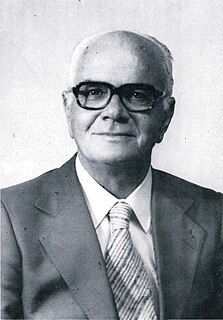
Umberto Rizzitano was an Italian academic, known for reviving Arab-Islamic studies in the University of Palermo and Sicily, neglected since the death of Michele Amari.
The Benevento dialect is a vernacular variety from the Campanian dialect that has undergone an evolution in a restricted space, roughly corresponding to the territory of the pontifical exclave of Benevento; this vernacular is placed side by side with other similar linguistic types referable to the same lineage and, in terms of phonetics, morphology and lexicon, it differs in some respects from Neapolitan.













